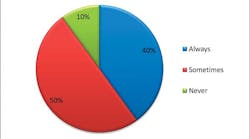Anesthesia is commonly used by dentists when they want to ensure young patients remain calm during an operation and feel as little pain as possible afterward. Dentist anesthesiologists may use either general or local anesthesia, but some choose to use both with children, despite conflicting research on the combined approach. The current issue of the journal Anesthesia Progress reports on a survey given to members of the American Society of Dentist Anesthesiologists (ASDA). It asked about anesthesia choices for young patients and reasons for supplementing general anesthesia with local anesthesia.ADDITIONAL READING |Intravenous sedation drug shows promise from results of clinical dental trial Prior studies have found that local anesthesia can benefit children undergoing dental procedures. Advantages include less distress in recovering from anesthesia and less pain after extractions. However, other reports have found no difference in postoperative pain. Some dentists skip local anesthesia in most cases because they fear the additional anesthetic will cause children to bite their lip or cheek after surgery. The current survey found a range of practices and rationales for anesthesia decisions. The e-mail-based survey was sent to 183 members of the ASDA, and responses were received from about 42% of the members.ADDITIONAL READING |Comfortably numb: how dental anesthesia can differentiate your endodontic practice The survey revealed that 90% of responding dentist anesthesiologists prefer the combined approach when treating some or most of their young patients. These respondents said the pairing makes it easier to stabilize the children’s vital signs while decreasing the depth of general anesthesia. They also reported that the children experience less pain and recover more quickly with dual anesthetics. Half of them decide on the approach based on the patient, and 40% supplement general with local anesthesia in all but a few cases. The survey also showed strong links between the type of practice, type of procedure, and whether there are other dentists involved. Most responding ASDA members administer only the anesthesia for children in dental offices and let the operating dentist decide whether to use local anesthesia. About 27% of respondents said they make the decision because they both administer the anesthesia and perform the operation. Local anesthesia is most often added when dentists were preparing to extract permanent or primary teeth. Despite the preference for administering both types of anesthesia, the survey authors found that little scientific evidence is available to ASDA members in making their decision. The authors noted that no prospective double-blind studies conclusively argue for or against the combined usage. Full text of the article “Use of local anesthesia during dental rehabilitation with general anesthesia: A survey of dentist anesthesiologists,” Anesthesia Progress, Vol. 61, No. 1, 2014, is now available here. Anesthesia Progress is the official publication of the American Dental Society of Anesthesiology. To learn more about the ADSA, visit their website.






